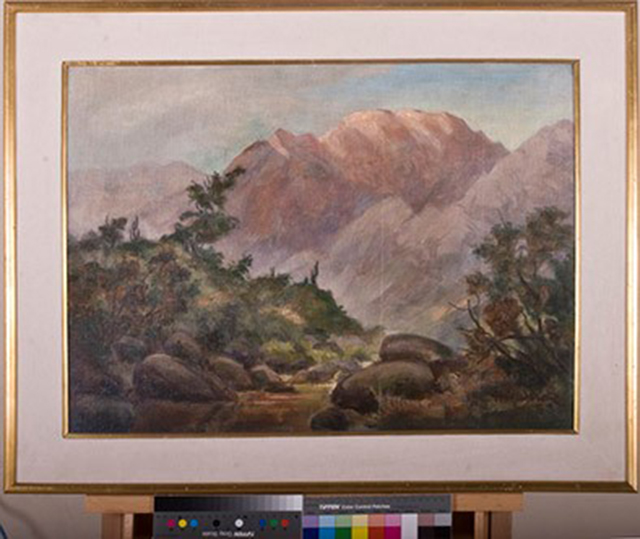
Paisaje montañoso, (1953)
Óleo sobre hardboard, 50 x 70 cm
En esta pintura de tamaño mediano, el artista nos presenta un paisaje de montaña con cierto sabor romántico. Desde una vista más bien alta, nos encontramos en un primer plano con un arroyo pequeño, rodeado de rocas grandes y redondas, de árboles y arbustos, acaso coníferas, de aguas rápidas, cristalinas y, en apariencia, gélidas. Atrás, la bruma divide los espacios y asoman tras ella grandes montañas rocosas que dan el título a la obra. Hendek demuestra todo su oficio de pintor de paisajes al presentarnos el espacio libre entre estos dos planos (el correspondiente al arroyo y el relativo a las montañas) brumoso, indefinido, pero tangible, amplio. En otras palabras, ha sabido usar la neutralidad de este lugar transitorio para dar profundidad a la obra dejándola dividida en dos zonas de valor: valores bajos y definidos para el primer plano, valores altos y etéreos para la perspectiva atmosférica de las montañas, lo cual otorga a la obra un clima sublime, oscilante entre la pintura atmosférica de la China Imperial y el paisaje subjetivo del romanticismo alemán. La paleta es fría, acotada, con dominantes en los azules y verdes y los grises cromáticos; y la factura es límpida, sin gran gestualidad, sin pinceladas que resulten más pregnantes y fuertes que el propio paisaje. Es una obra calma, interesante, que ilustra la mirada subjetiva del artista sobre un paisaje que no le dejare indiferente al contemplarlo, y que, a través del filtro de su paleta, también nos trasciende y nos altera.
Mountainous Landscape, (1953)
Oil on hardboard, 50 x 70 cm
In this médium-sized painting, the artista presents us with a mountain landscape with a certain romantic flavor. From a rather high view, we find ourselves in the foreground with a small stream, surrounded by large, round rocks, tres and bushes, perhaps conifers, with fast, crystalline and, apparently, icy waters. Behind, the mist divides the spaces and large rocky mountains appear behind ir, giving the work its title. Hendek demonstrates all his craft as a landscape painter by presenting us with the free space between these two planes (the one coresponding to the stream and the one related to the mountains), misty, indefinite, but tangible, spacious. In other words, he has known how to use the neutrality of this transitory place to give depth to the work, leaving ir divided into two zones of value: low and defined values for the foreground, high and ethereal values for the atmspheric perspective of the mountains, which ir gives the work a sublime atmosphere, oscillating between the atmospheric painting of Imperial China and the subjective landscape of German Romanticism. The pallete is cold, limited, with blues and greens and chromatic grays dominant; and the work is limpid, without great gestures, without brushstrokes that are more pregnant and stronger than the landscape itself. It is a calm, interesting work that illustrates the artist’s subjective view of a landscape that will not leave you indifferent when contemplating it, and that, through the filter of his palette, also transcends and alter us.